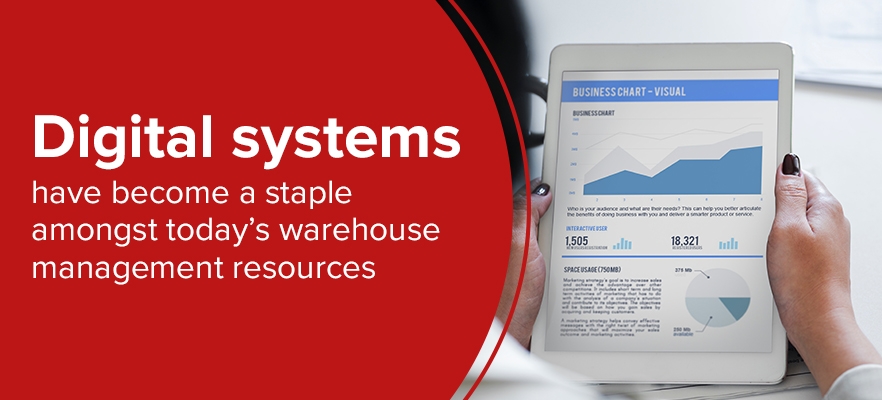Complete Guide to Warehouse Management: Chapter 4
Managing Warehouse Equipment: Machinery, Computer Systems and Supporting Warehouse Tools
While you can never, ever underestimate the power of a reliable, well-trained warehouse workforce, that workforce is only as fast as its in-house equipment.
In today’s world, warehouse machinery is no longer a luxury. It's a necessary business asset with some serious return on investment — one that bolsters your warehouse's ability to stay relevant and competitive in an ever-tight manufacturing landscape.
In fact, the proper implementation of warehouse equipment can increase labor outputs, and therefore profitability, by 20 to 50 percent.

It’s already likely you understand the importance of high-functioning and readily available warehouse equipment, such as scissor lifts to reach top-shelf storage, pallets, spacer retrievers and stretch wrappers that wrap shipments in seconds. But the pace at which machine and digital solutions are evolving can make it hard to feel on-par with industry expectations — much less guaranteeing you’re putting investments to best use.
Yet it’s this very equipment — mechanical and digital — that can make or break the efficiency of warehouse operations.
Managing Warehouse Equipment
From handling heavy loads and easing SKU transportation to ensuring storage cleanliness and compliance, you need a fleet of high-functioning mechanical equipment to move, stack, label and retrieve inventory.
After all, these operations are the backbone of your warehouse. They are the workhorses that allow your employees to perform key functions. They do not take away from the value of these employees or relegate personnel to subsidiary concerns. These machines are simply the reality of the industry.
And while all technology comes with limitations, warehouse management systems are amiss if they don’t see machinery use, maintenance and monitorization as part of daily operations.
Today’s necessary warehouse equipment includes:
-
Unit load carriers
-
Pallet jacks
-
Lift equipment, such as forklifts, scissor lifts and stackers
-
Pallet racks for empty pallets
-
Shelving, suited for the size and inventory scale of your warehouse
-
Hand and platform trucks
-
Service carts
-
Fully-stocked wrapping and packaging stations
-
Cabinets and lockers
-
Ladders
This list is hardly exhaustive. It represents the minimal material handling equipment needed to operate a storage warehouse and the functional necessities of floor operations. These very same operations are vastly improved with contemporary mechanical fleets tailored to your specific warehouse to help you create business advantages and future, scalable growth.
For a more in-depth look at contemporary material handling equipment, consult a product catalog or contact your local industrial equipment expert.
Perform routine inspections on all warehouse equipment, and always review product warranties. Consistently screen and set up maintenance schedules on material handling equipment to ensure you meet compliance and operational standards.
Warehouse Management Systems
On top of mechanical equipment, digital systems have become a staple amongst today’s warehouse management resources.

These digital warehouse management systems can be as in-depth or interwoven into all warehouse operations as you’d like. Yet they can also be implemented in smaller, strategic points, performing singular tasks. The most common digital management systems include:
1. Automated Data Collection
Automated data-collection tools use bar-code scanners or radio frequency identification to scan and index new inventory. These tools are nearly always stationed at shipment receiving or consignment areas to help personnel quickly classify SKUs. They increase sorting productivity and accuracy in product identification while cutting order-processing times.
2. Inventory or Warehouse Management Systems
Software that keeps track of all product data and inventory within your warehouse, in real time, is increasingly becoming the industry standard. There are dozens of these software packages on the market. The best integrate all warehouse workflow steps, from cataloging your complete inventory and calculating inventory turns to housing the portal that receives and tracks consumer orders. With a few simple clicks, you have tightened product organization, control, tracking and retrieving capabilities — the dream of many warehouse managers.
3. Designated Return Procedure
Many warehouses still overlook the importance of a formal, automated return procedure in their warehouse management systems. Digital or computerized return programs offer a solution. Implement a tailored one today that checkmarks all stages of returned warehouse goods, from item identification, reconsignment and physical sorting to return to shelves and accounting refunds or customer credit.
Warehouse Management Resources and Tools
There is no one way to best manage a warehouse. There is no one tool, computer software or piece of equipment that can perform every warehouse function at the snap of your fingers. Yet you can still introduce cutting-edge managerial practices into operations — especially administrative practices that highlight new and efficient uses for updated floor technology.
1. Cycle Count Systems
In addition to the inventory turns and regular product audits you perform, implement quarterly or bi-annual cycle counts. These are more controlled measurements of the shelf-life cycle of individual pockets of your inventory, which will lend your back office even more pinpointed data on the popularity and sale periods of each warehouse product.
Once performed, you can save cycle counts into your warehouse management system. Reports can then be generated and shared, leading to data-driven business decisions on the direction of your warehouse scale and inventory.
2. Strategic Picklists
For regular customers or those with routine high-volume orders, implement what’s called a coordinated picklist.
Picklists can be both digital and physical. On shelving or in your internal warehouse management system, picklists color code or provide similar visual cues designating the importance of an order. You can also set up custom signals for individual clients, save files and documents by picklist codes and set up workflow execution based on a picklist's priorities.





